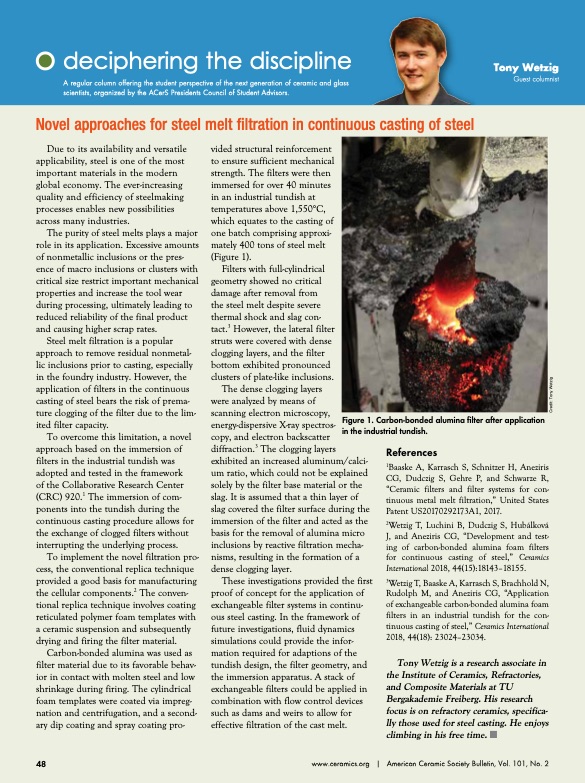
PDF Publication Title:
Text from PDF Page: 050
deciphering the discipline A regular column offering the student perspective of the next generation of ceramic and glass scientists, organized by the ACerS Presidents Council of Student Advisors. Tony Wetzig Guest columnist Novel approaches for steel melt filtration in continuous casting of steel Due to its availability and versatile applicability, steel is one of the most important materials in the modern global economy. The ever-increasing quality and efficiency of steelmaking processes enables new possibilities across many industries. The purity of steel melts plays a major role in its application. Excessive amounts of nonmetallic inclusions or the pres- ence of macro inclusions or clusters with critical size restrict important mechanical properties and increase the tool wear during processing, ultimately leading to reduced reliability of the final product and causing higher scrap rates. Steel melt filtration is a popular approach to remove residual nonmetal- lic inclusions prior to casting, especially in the foundry industry. However, the application of filters in the continuous casting of steel bears the risk of prema- ture clogging of the filter due to the lim- ited filter capacity. To overcome this limitation, a novel approach based on the immersion of filters in the industrial tundish was adopted and tested in the framework of the Collaborative Research Center (CRC) 920.1 The immersion of com- ponents into the tundish during the continuous casting procedure allows for the exchange of clogged filters without interrupting the underlying process. To implement the novel filtration pro- cess, the conventional replica technique provided a good basis for manufacturing the cellular components.2 The conven- tional replica technique involves coating reticulated polymer foam templates with a ceramic suspension and subsequently drying and firing the filter material. Carbon-bonded alumina was used as filter material due to its favorable behav- ior in contact with molten steel and low shrinkage during firing. The cylindrical foam templates were coated via impreg- nation and centrifugation, and a second- ary dip coating and spray coating pro- vided structural reinforcement to ensure sufficient mechanical strength. The filters were then immersed for over 40 minutes in an industrial tundish at temperatures above 1,550°C, which equates to the casting of one batch comprising approxi- mately 400 tons of steel melt (Figure 1). Filters with full-cylindrical geometry showed no critical damage after removal from the steel melt despite severe thermal shock and slag con- tact.3 However, the lateral filter struts were covered with dense clogging layers, and the filter bottom exhibited pronounced clusters of plate-like inclusions. 48 www.ceramics.org | American Ceramic Society Bulletin, Vol. 101, No. 2 The dense clogging layers were analyzed by means of scanning electron microscopy, energy-dispersive X-ray spectros- copy, and electron backscatter diffraction.3 The clogging layers exhibited an increased aluminum/calci- um ratio, which could not be explained solely by the filter base material or the slag. It is assumed that a thin layer of slag covered the filter surface during the immersion of the filter and acted as the basis for the removal of alumina micro inclusions by reactive filtration mecha- nisms, resulting in the formation of a dense clogging layer. These investigations provided the first proof of concept for the application of exchangeable filter systems in continu- ous steel casting. In the framework of future investigations, fluid dynamics simulations could provide the infor- mation required for adaptions of the tundish design, the filter geometry, and the immersion apparatus. A stack of exchangeable filters could be applied in combination with flow control devices such as dams and weirs to allow for effective filtration of the cast melt. Figure 1. Carbon-bonded alumina filter after application in the industrial tundish. References 1Baaske A, Karrasch S, Schnitzer H, Aneziris CG, Dudczig S, Gehre P, and Schwarze R, “Ceramic filters and filter systems for con- tinuous metal melt filtration,” United States Patent US20170292173A1, 2017. 2Wetzig T, Luchini B, Dudczig S, Hubálková J, and Aneziris CG, “Development and test- ing of carbon-bonded alumina foam filters for continuous casting of steel,” Ceramics International 2018, 44(15):18143–18155. 3Wetzig T, Baaske A, Karrasch S, Brachhold N, Rudolph M, and Aneziris CG, “Application of exchangeable carbon-bonded alumina foam filters in an industrial tundish for the con- tinuous casting of steel,” Ceramics International 2018, 44(18): 23024–23034. Tony Wetzig is a research associate in the Institute of Ceramics, Refractories, and Composite Materials at TU Bergakademie Freiberg. His research focus is on refractory ceramics, specifica- lly those used for steel casting. He enjoys climbing in his free time. n Credit: Tony WetzigPDF Image | hydrogen as an alternative fuel

PDF Search Title:
hydrogen as an alternative fuelOriginal File Name Searched:
March2022.pdfDIY PDF Search: Google It | Yahoo | Bing
CO2 Organic Rankine Cycle Experimenter Platform The supercritical CO2 phase change system is both a heat pump and organic rankine cycle which can be used for those purposes and as a supercritical extractor for advanced subcritical and supercritical extraction technology. Uses include producing nanoparticles, precious metal CO2 extraction, lithium battery recycling, and other applications... More Info
Heat Pumps CO2 ORC Heat Pump System Platform More Info
| CONTACT TEL: 608-238-6001 Email: greg@infinityturbine.com | RSS | AMP |